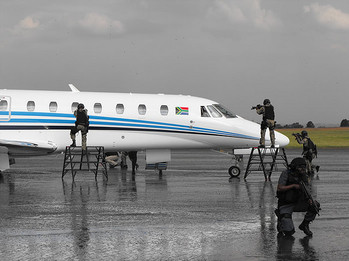Why kidnapping survival training?
Why psychology?

Most victims survive
The presentation on this page outlines the challenges of kidnapping, based on four different phases. Kidnapping Survival stands out for its uniqe training, primarily in the phase of captivity (see below). Lessons from social psychology are drawn upon systematically to improve survival odds, an approach that is not common among trainers.
Kidnapping represents a range of heavy challenges and happens in a number of different contexts. It may happen as a means to commit violence, to escape a crime scene or to extort ransom. In recent years some countries have seen an increase in socalled Tiger kidnappings, where a senior excutive or his/her family members are kidnapped for ransom. Kidnapping is often linked to hijacking. What challenges does kidnapping imply?
While most victims survive, there is always a risk of injuries and trauma. Whatever the context, victims must try to avert violence, preserve their health and apply psychological influence to make the kidnappers treat them as well as possible. One can only expect to do this well if prepared, and preparedness can best be achieved through training.
Kidnapping represents a range of heavy challenges and happens in a number of different contexts. It may happen as a means to commit violence, to escape a crime scene or to extort ransom. In recent years some countries have seen an increase in socalled Tiger kidnappings, where a senior excutive or his/her family members are kidnapped for ransom. Kidnapping is often linked to hijacking. What challenges does kidnapping imply?
While most victims survive, there is always a risk of injuries and trauma. Whatever the context, victims must try to avert violence, preserve their health and apply psychological influence to make the kidnappers treat them as well as possible. One can only expect to do this well if prepared, and preparedness can best be achieved through training.

Can we reduce the risk of violence?
Most kidnappings include four phases:
The ASSAULT PHASE is a tremendous shock. The first challenge is to get control of one's own mind, and focus on what is important there and then. Violence is a threat at this stage, and victims should know how they can reduce the risk. This is about calm, body language and application of certain techniques.
This is also a time to assess the possibility of escape. If violence seems likely, escape may be essential. If taken by the Abu Sayyaf secessionist group in the Philippines, or someone appearing to be a rapist, one would look for any possibility of escape. If taken hostage as a crew member on a ship in Nigeria while the pirates are unloading the cargo, one would normally play it cool and wait for the likely release.
If escape is impossible, this stage should be used to focus on the kidnappers and make observations that could be useful later. This includes getting the best possible impression of the kidnappers, their leader, significant traits and if feasible their identity. One should also take note of the time and place of the incident, as this may help assessing where one is being transported next.
The assault phase is normally followed by a TRANSPORTATION PHASE, when the victim is being brought to the kidnappers’ hideout. This phase can be gruelling. A victim may be injured, put in cramped position, gagged or blindfolded. The main challenge is to keep composed, calm and try to make observations that could help in case of an escape or contact with the outside world later. If possible one may also look out for escape opportunities on the way.
Once the CAPTIVITY PHASE is a fact and the victim has to brave it out, there are a number of heavy challenges.
· How to relate to stress and the risk of trauma?
There are important mental and practical tools one should know about.
· How do we ensure unity and solidarity if abducted as a group?
Kidnappers often try to split the victims, and lack of unity sometimes has tragic effects.
· How to relate to angry kidnappers or psychopats?
How to relate to violent attacks and torture? There are techniques for averting attacks,
but victims should also know how to act after a violent attack or torture.
· The use of psychological influence
Can we influence the kidnappers in order to increase the chances of surviving and reduce the chances of
mistreatment? This is about social psychology, a science little known to most victims. Some real life examples may
serve as illustrations:
- UN Special Representative to Niger, Robert Fowler, was kidnapped together with his colleague Louis Guay in 2008
and taken to Mali by Al Qaida in Magreb. The two men, both experienced and resourceful, disagreed on how to
relate to the kidnappers. Fowler believed they should appear as bearing up (staunch, brave and healthy) whereas
Louis Guay believed it was better to appear as frail and dejected (depressed and vulnerable).(Robert Fowler ’ A
Season in Hell’, Harper Collins Publishers Ltd, Toronto, 2011 ). One of the men increased his survival chances
through his attitude. Our training or the book Kidnapping Survival will help you understand how.
- After having injured his back during transportation, Robert Fowler was asked by a leadning kidnapper if there was
anything they could do to make him more comfortable. He answered that there was not. While surely a natural
answer, this was probably a lost opportunity of influence.
- After the release of the ship MT Marida Marguerite that was hijacked on the coast of Somalia from May to
December 2010, one crew member revealed that some of the crew had sided with the hijackers, giving them
information officers had tried to hide. This lead to a break-down of the relationship between the officers and
the hijackers, followed by severe torture. (Interview by Olav Ofstad 29.08.2012) Later, the officers were able
to improve the relationship with the hijackers, and the torture ended. What mechanisms were at play? What
caused the betrayal, and can such acts be prevented? How was the relationship with the kidnappers improved?
Sometimes victims are able to use psychological tools. They may do so unwittingly, by talent or intuition:
- Newspaper editor Gerard Vaders was part of a group kidnapped by terrorists in the South Moluccas in 1975.
He was selected for execution, but was allowed to talk to one of the fellow captives first, while the
kidnappers listened.
This conversation saved his life. (Strentz T: The Stockholm Syndrome: Law Enforcement and Ego Defenses of
the Hostage, Ann. N.Y. Acad, Sci, 347:137-150, 1980)
How could this happen?
- Researcher Francois Bizot was captured by Khmer Rouge guerrillas in Cambodia in 1974 and held under the
command of a man named Douch, termed Khmer Rouge's worst torturer. (Francois Bizot, 'The Gate', Vintage
Books, New York 2002) Because of the way Bizot related to his captor, Douch protected him and advocated his
case with Khmer Rouge leaders, and he was released after 4 months, unharmed.
How did Bizot act to achieve this?
- See also an interesting dialogue from a hijacking situation at sea under Conflict Management.
The ASSAULT PHASE is a tremendous shock. The first challenge is to get control of one's own mind, and focus on what is important there and then. Violence is a threat at this stage, and victims should know how they can reduce the risk. This is about calm, body language and application of certain techniques.
This is also a time to assess the possibility of escape. If violence seems likely, escape may be essential. If taken by the Abu Sayyaf secessionist group in the Philippines, or someone appearing to be a rapist, one would look for any possibility of escape. If taken hostage as a crew member on a ship in Nigeria while the pirates are unloading the cargo, one would normally play it cool and wait for the likely release.
If escape is impossible, this stage should be used to focus on the kidnappers and make observations that could be useful later. This includes getting the best possible impression of the kidnappers, their leader, significant traits and if feasible their identity. One should also take note of the time and place of the incident, as this may help assessing where one is being transported next.
The assault phase is normally followed by a TRANSPORTATION PHASE, when the victim is being brought to the kidnappers’ hideout. This phase can be gruelling. A victim may be injured, put in cramped position, gagged or blindfolded. The main challenge is to keep composed, calm and try to make observations that could help in case of an escape or contact with the outside world later. If possible one may also look out for escape opportunities on the way.
Once the CAPTIVITY PHASE is a fact and the victim has to brave it out, there are a number of heavy challenges.
· How to relate to stress and the risk of trauma?
There are important mental and practical tools one should know about.
· How do we ensure unity and solidarity if abducted as a group?
Kidnappers often try to split the victims, and lack of unity sometimes has tragic effects.
· How to relate to angry kidnappers or psychopats?
How to relate to violent attacks and torture? There are techniques for averting attacks,
but victims should also know how to act after a violent attack or torture.
· The use of psychological influence
Can we influence the kidnappers in order to increase the chances of surviving and reduce the chances of
mistreatment? This is about social psychology, a science little known to most victims. Some real life examples may
serve as illustrations:
- UN Special Representative to Niger, Robert Fowler, was kidnapped together with his colleague Louis Guay in 2008
and taken to Mali by Al Qaida in Magreb. The two men, both experienced and resourceful, disagreed on how to
relate to the kidnappers. Fowler believed they should appear as bearing up (staunch, brave and healthy) whereas
Louis Guay believed it was better to appear as frail and dejected (depressed and vulnerable).(Robert Fowler ’ A
Season in Hell’, Harper Collins Publishers Ltd, Toronto, 2011 ). One of the men increased his survival chances
through his attitude. Our training or the book Kidnapping Survival will help you understand how.
- After having injured his back during transportation, Robert Fowler was asked by a leadning kidnapper if there was
anything they could do to make him more comfortable. He answered that there was not. While surely a natural
answer, this was probably a lost opportunity of influence.
- After the release of the ship MT Marida Marguerite that was hijacked on the coast of Somalia from May to
December 2010, one crew member revealed that some of the crew had sided with the hijackers, giving them
information officers had tried to hide. This lead to a break-down of the relationship between the officers and
the hijackers, followed by severe torture. (Interview by Olav Ofstad 29.08.2012) Later, the officers were able
to improve the relationship with the hijackers, and the torture ended. What mechanisms were at play? What
caused the betrayal, and can such acts be prevented? How was the relationship with the kidnappers improved?
Sometimes victims are able to use psychological tools. They may do so unwittingly, by talent or intuition:
- Newspaper editor Gerard Vaders was part of a group kidnapped by terrorists in the South Moluccas in 1975.
He was selected for execution, but was allowed to talk to one of the fellow captives first, while the
kidnappers listened.
This conversation saved his life. (Strentz T: The Stockholm Syndrome: Law Enforcement and Ego Defenses of
the Hostage, Ann. N.Y. Acad, Sci, 347:137-150, 1980)
How could this happen?
- Researcher Francois Bizot was captured by Khmer Rouge guerrillas in Cambodia in 1974 and held under the
command of a man named Douch, termed Khmer Rouge's worst torturer. (Francois Bizot, 'The Gate', Vintage
Books, New York 2002) Because of the way Bizot related to his captor, Douch protected him and advocated his
case with Khmer Rouge leaders, and he was released after 4 months, unharmed.
How did Bizot act to achieve this?
- See also an interesting dialogue from a hijacking situation at sea under Conflict Management.

Release by force is dramatic and confusing.
Unfortunately we can not trust our talent or intuition to ensure the use of such psychological tools. The challenges and tools selected above need explanation to be understood. So do a number of other essential tools that captives may use. As most victims do not know or understand them, they often make wrong choices, sometimes with tragic consequences.
In the RELEASE PHASE the challenges are different. While most voluntary releases by kidnappers happen smoothly, such situations can be tense and dangerous, and knowledge of how to behave is essential. And what if an effort is made to free a victim by force? This is a very dramatic and confusing situation that sometimes ends tragically because the victims do not know how to behave. Again, preparedness is essential.
Unfortunately, few kidnap victims have been through the training needed for adequate preparedness. The training offered by Kidnapping Survival addresses all the above challenges, but stands out in that it integrates traditional security knowledge with structured application of social psychology. See Conflict Management, The Science and A Book For Clients.
In the RELEASE PHASE the challenges are different. While most voluntary releases by kidnappers happen smoothly, such situations can be tense and dangerous, and knowledge of how to behave is essential. And what if an effort is made to free a victim by force? This is a very dramatic and confusing situation that sometimes ends tragically because the victims do not know how to behave. Again, preparedness is essential.
Unfortunately, few kidnap victims have been through the training needed for adequate preparedness. The training offered by Kidnapping Survival addresses all the above challenges, but stands out in that it integrates traditional security knowledge with structured application of social psychology. See Conflict Management, The Science and A Book For Clients.
